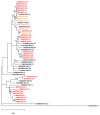Co-Circulation of Different Hepatitis E Virus Genotype 3 Subtypes in Pigs and Wild Boar in North-East Germany, 2019
- PMID: 35890018
- PMCID: PMC9317891
- DOI: 10.3390/pathogens11070773
Co-Circulation of Different Hepatitis E Virus Genotype 3 Subtypes in Pigs and Wild Boar in North-East Germany, 2019
Abstract
Hepatitis E is a major cause of acute liver disease in humans worldwide. The infection is caused by hepatitis E virus (HEV) which is transmitted in Europe to humans primarily through zoonotic foodborne transmission from domestic pigs, wild boar, rabbits, and deer. HEV belongs to the family Hepeviridae, and possesses a positive-sense, single stranded RNA genome. This agent usually causes an acute self-limited infection in humans, but in people with low immunity, e.g., immunosuppressive therapy or underlying liver diseases, the infection can evolve to chronicity and is able to induce a variety of extrahepatic manifestations. Pig and wild boar have been identified as the primary animal reservoir in Europe, and consumption of raw and undercooked pork is known to pose a potential risk of foodborne HEV infection. In this study, we analysed pig and wild boar liver, faeces, and muscle samples collected in 2019 in Mecklenburg-Western Pomerania, north-east Germany. A total of 393 animals of both species were investigated using quantitative real-time reverse transcription polymerase chain reaction (RT-qPCR), conventional nested RT-PCR and sequence analysis of amplification products. In 33 animals, HEV RNA was detected in liver and/or faeces. In one individual, viral RNA was detected in muscle tissue. Sequence analysis of a partial open reading frame 1 region demonstrated a broad variety of genotype 3 (HEV-3) subtypes. In conclusion, the study demonstrates a high, but varying prevalence of HEV RNA in swine populations in Mecklenburg-Western Pomerania. The associated risk of foodborne HEV infection needs the establishment of sustainable surveillance and treatment strategies at the interface between humans, animals, and the environment within a One Health framework.
Keywords: HEV-3; Hepeviridae; One Health; genotype; reservoir; subtype; transmission.
Conflict of interest statement
The authors declare no conflict of interest. The funders had no role in the design of the study; in the collection, analyses, or interpretation of data; in the writing of the manuscript, or in the decision to publish the results.
Figures


Similar articles
-
Prevalence and phylogenetic analysis of hepatitis E virus in pigs, wild boars, roe deer, red deer and moose in Lithuania.Acta Vet Scand. 2018 Feb 23;60(1):13. doi: 10.1186/s13028-018-0367-7. Acta Vet Scand. 2018. PMID: 29471843 Free PMC article.
-
Molecular Investigation on the Presence of Hepatitis E Virus (HEV) in Wild Game in North-Western Italy.Food Environ Virol. 2015 Sep;7(3):206-12. doi: 10.1007/s12560-015-9201-9. Epub 2015 May 26. Food Environ Virol. 2015. PMID: 26006251
-
Chronically infected wild boar can transmit genotype 3 hepatitis E virus to domestic pigs.Vet Microbiol. 2015 Oct 22;180(1-2):15-21. doi: 10.1016/j.vetmic.2015.08.022. Epub 2015 Aug 29. Vet Microbiol. 2015. PMID: 26344041
-
Swine hepatitis E virus: Cross-species infection, pork safety and chronic infection.Virus Res. 2020 Jul 15;284:197985. doi: 10.1016/j.virusres.2020.197985. Epub 2020 Apr 23. Virus Res. 2020. PMID: 32333941 Free PMC article. Review.
-
Hepatitis E: an emerging global disease - from discovery towards control and cure.J Viral Hepat. 2016 Feb;23(2):68-79. doi: 10.1111/jvh.12445. Epub 2015 Sep 6. J Viral Hepat. 2016. PMID: 26344932 Review.
Cited by
-
Hepatitis E Virus (HEV) Infection in the Context of the One Health Approach: A Systematic Review.Pathogens. 2025 Jul 16;14(7):704. doi: 10.3390/pathogens14070704. Pathogens. 2025. PMID: 40732750 Free PMC article. Review.
-
Molecular and serological investigation of Hepatitis E virus in pigs slaughtered in Northwestern Italy.BMC Vet Res. 2023 Jan 25;19(1):21. doi: 10.1186/s12917-023-03578-4. BMC Vet Res. 2023. PMID: 36698186 Free PMC article.
-
Serological and Molecular Survey of Hepatitis E Virus in Small Ruminants from Central Portugal.Food Environ Virol. 2024 Dec;16(4):516-524. doi: 10.1007/s12560-024-09612-4. Epub 2024 Sep 5. Food Environ Virol. 2024. PMID: 39235492 Free PMC article.
-
Characterization of a Near Full-Length Hepatitis E Virus Genome of Subtype 3c Generated from Naturally Infected South African Backyard Pigs.Pathogens. 2022 Sep 11;11(9):1030. doi: 10.3390/pathogens11091030. Pathogens. 2022. PMID: 36145462 Free PMC article.
-
Seroprevalence of the Hepatitis E Virus in Indigenous and Non-Indigenous Communities from the Brazilian Amazon Basin.Microorganisms. 2024 Feb 10;12(2):365. doi: 10.3390/microorganisms12020365. Microorganisms. 2024. PMID: 38399768 Free PMC article.
References
-
- WHO Hepatitis E. 2022. [(accessed on 10 March 2022)]. Available online: https://www.who.int/en/news-room/fact-sheets/detail/hepatitis-e.
-
- Smith D.B., Simmonds P., Jameel S., Emerson S.U., Harrison T.J., Meng X.J., Okamoto H., Van der Poel W.H.M., Purdy M.A., International Committee on the Taxonomy of Viruses Hepeviridae Study Group Consensus proposals for classification of the family Hepeviridae. J. Gen. Virol. 2014;95:2223–2232. doi: 10.1099/vir.0.068429-0. - DOI - PMC - PubMed
Grants and funding
LinkOut - more resources
Full Text Sources

